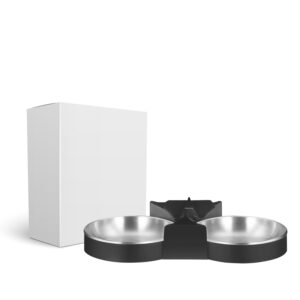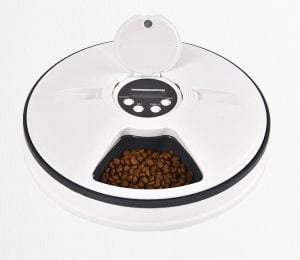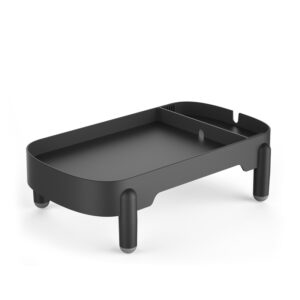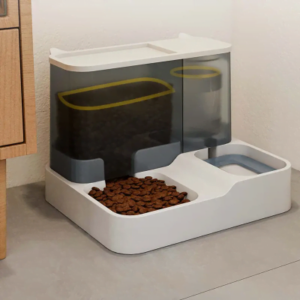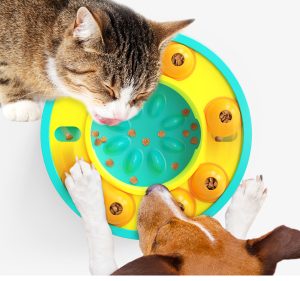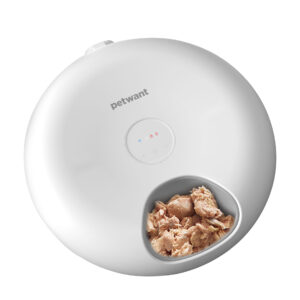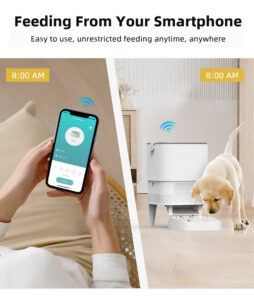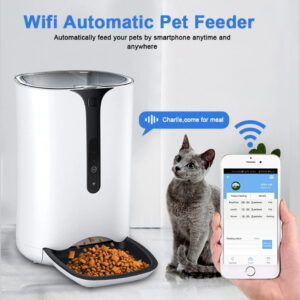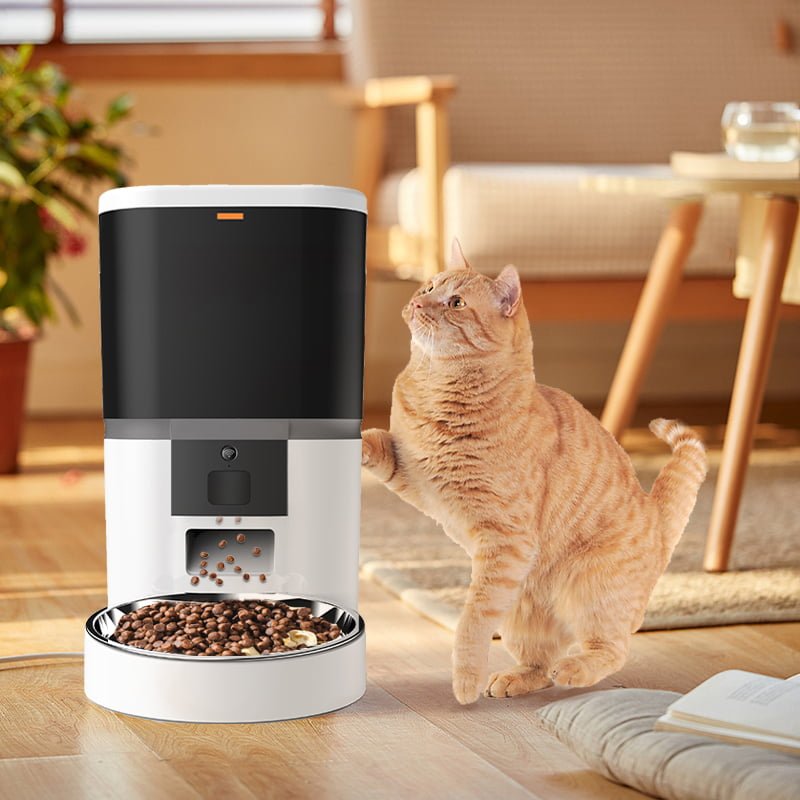0
The Importance of a Consistent Feeding Schedule for Dogs and Cats
By Gavin Levenstein Updated 13 May 2025
Quick answer (for busy pet parents)
- Dogs
– Puppies 8–12 weeks: 4 small meals/day – Puppies 3–6 months: 3 meals/day – 6–12 months: 2–3 meals/day (large-breed puppies often stay on 3 longer) – Adults: 2 meals/day about 12 hours apart – Seniors: 2 smaller meals/day
- Cats
– Kittens 8–12 weeks: 4 meals/day – Kittens 3–6 months: 3–4 meals/day – Adults: 2–3 scheduled meals/day (measured portions), or carefully measured “free feeding” for grazers – Seniors: 3 smaller meals/day, or 2–3 if appetite is stable
Typical times that work well
- Two meals: 07:00 and 19:00
- Three meals: 07:00, 12:30, 19:00
- Four meals (young puppies/kittens): 07:00, 11:00, 15:00, 19:00
Jump to:
- Dog feeding schedule by age and size
- Cat feeding schedule by age and lifestyle
- Scheduled vs free feeding
- How to create and stick to a schedule
- Best automatic feeders (battery backup for SA)
- FAQs
Why consistency matters (the science, simply)
A regular feeding schedule is more than convenience—it’s a cornerstone of your pet’s well-being. Dogs and cats run on circadian rhythms that regulate hormones, digestion, and energy. Feeding at predictable times “sets” those internal clocks. The result? Smoother digestion, steadier metabolism, calmer behavior, and easier house training for dogs.
Benefits of a regular routine
- Digestive health: The body anticipates meals and releases digestive enzymes at the right time, improving comfort and nutrient absorption.
- Metabolic stability and healthy weight: Predictable meals help prevent fat storage from “feast/famine” swings and make portion control simpler.
- Better behavior: Routine reduces stress, food guarding, and tension—especially in multi-pet homes.
- Easier house training and health monitoring: Consistent meals lead to more predictable toilet times and make it easier to spot appetite or stool changes early.
—
Dog feeding schedule by age and size
How many times a day should I feed my dog? Use this as a starting point and adjust with your vet based on body condition and energy.
- Puppies 8–12 weeks: 4 meals/day (small, frequent to support growth)
- Puppies 3–6 months: 3 meals/day
- 6–12 months:
– Toy/small/medium breeds: 2–3 meals/day – Large/giant breeds: 3 meals/day until growth slows, then 2 meals/day
- Adult dogs: 2 meals/day, roughly 12 hours apart
- Seniors: 2 smaller meals/day to support digestion and blood sugar
Tip: For anxious dogs, keep mealtimes calm and predictable; pair meals with a short sniff-walk after eating.
Example day for an adult dog (2 meals)
- 07:00 breakfast, short walk after
- 19:00 dinner, calm enrichment (lick mat, gentle play) after
—
Cat feeding schedule by age and lifestyle
How many times a day should I feed my cat? Cats are natural grazers but do best with measured routines to prevent obesity—especially indoor cats.
- Kittens 8–12 weeks: 4 meals/day
- Kittens 3–6 months: 3–4 meals/day
- Adult cats:
– Indoor or weight-prone: 2–3 scheduled meals/day with measured portions – Active cats: 2–3 meals/day or measured free feeding if weight is stable
- Senior cats: 3 smaller meals/day can help with appetite and dental comfort
To reduce night waking
- Give the last meal 1–2 hours before your bedtime.
- Add a short play session (hunt-pounce-eat-groom-sleep cycle) just before that final meal.
—
Scheduled vs free feeding: pros and cons
- Scheduled feeding (recommended for most pets)
– Pros: Portion control, better weight management, predictable toilet times, fewer food fights in multi-pet homes. – Cons: Requires planning if you work late—an automatic feeder solves this.
- Free feeding (measured total per day, left out)
– Pros: Suits some cats that self-regulate. – Cons: Promotes overeating in many pets, harder to monitor intake, risky in multi-pet homes.
How to switch a dog or cat to scheduled feeding
- Days 1–3: Pick set meal times. Offer measured food. Remove leftovers after 15–20 minutes.
- Days 4–7: Keep times consistent. Adjust portion slightly if bowls are licked clean too fast or food is regularly left over.
- Week 2+: Maintain routine. For grazers, split the same daily total into smaller, scheduled mini-meals.
—
How to create a feeding schedule (step-by-step)
1) Choose times you can keep daily (weekends too). Anchor around your wake/return times. 2) Calculate portions using your food’s feeding guide and your pet’s ideal weight. When in doubt, ask your vet. 3) Split the total daily amount across meals (e.g., 50% breakfast, 50% dinner; or 40/30/30 for three meals). 4) Serve meals in the same place with a calm cue. Offer water at all times. 5) Track body condition weekly. If ribs vanish under padding, reduce portions slightly; if ribs are prominent, increase modestly—always check with your vet. 6) Reassess every 4–6 weeks or after life changes (growth, sterilisation, return-to-office routines).
Helpful tools
- Download: Printable weekly feeding schedule (PDF)
/downloads/tailme-feeding-schedule-template.pdf
- Coming soon: Simple on-page meal planner to calculate meals/day and portion guidance. Always follow your vet’s advice.
—
Best automatic feeders to maintain routine in South Africa (battery backup)
When life is unpredictable—or during load shedding—automatic feeders keep mealtimes dependable.
What to look for (mini buyer’s guide)
- Battery backup or dual-power: Essential for load shedding in SA.
- App control and scheduling: Set precise times, get low-food alerts, and log feeding history.
- Portion control: Fine increments for small pets; larger capacities for big dogs.
- Wet vs dry compatibility: Some models keep wet food cool with ice packs.
- Multi-pet solutions: Microchip or collar-tag feeders that open only for the right pet.
- Easy clean: Removable, dishwasher-safe bowls and food paths.
Shop our recommended categories
- Dog Auto Feeders (with battery-backup options): https://www.tailme.co.za/product-category/dogs/auto-feeders/
- Cat Auto Feeders (including microchip and smart options): https://www.tailme.co.za/product-category/cats/auto-feeders/
Travel tip: For weekends away, choose a travel-friendly automatic feeder with secure locking lids and a stable base.
—
Multi-pet homes: peace at mealtime
- Zone feeding: Feed pets in separate areas or rooms.
- Microchip feeders: Assign meals to the right pet; ideal if one is on a prescription diet.
- Slow feeders and lick mats: Reduce gulping and food guarding.
- Staggered schedules: Feed the faster eater first and the slower, anxious pet second in a quiet space.
—
Real-life examples you can copy today
- Puppy 12 weeks (4 meals): 07:00, 11:00, 15:00, 19:00
- Large-breed puppy 5 months (3 meals): 07:00, 13:00, 19:00
- Adult dog (2 meals): 07:00, 19:00
- Indoor adult cat (3 meals): 07:30, 13:00, 21:00 with a 5–10 min play session before the last meal
- Senior cat with small-meal preference (3 meals): 07:00, 14:00, 20:00
—
FAQs
Q: Is it OK to feed a dog once a day? A: Some healthy adult dogs do well on one meal, but many experience hunger-related vomiting (empty-stomach bile) or begging. Two smaller meals are safer for digestion, energy, and mood. Large/giant breeds are often kept on 2 meals to reduce bloat risk. Always ask your vet before changing.
Q: What time should I feed my cat at night to stop early wake-ups? A: Give the final meal 1–2 hours before bed, after a short play session. Keep mornings boring until your chosen breakfast time—consistency prevents dawn wake-ups.
Q: How much should I feed my puppy or kitten per meal? A: Use your food’s life-stage guide for weight and age. Divide the total daily amount by the number of meals (e.g., 300 g/day split into 4 meals = 75 g/meal). Re-check weekly as they grow and confirm with your vet.
Q: Scheduled feeding vs free feeding for cats—what’s best? A: For indoor or overweight-prone cats, scheduled and measured meals help prevent obesity. Free feeding can work for true self-regulators, but always measure the daily total and monitor weight.
Q: Can an automatic feeder help with house training a puppy? A: Yes. Predictable meals lead to predictable potty windows, which makes house training more consistent—especially if different family members handle feeds.
Q: How do I maintain a schedule when I work late or during load shedding? A: Use an automatic feeder with app scheduling and battery backup. Set times once and let it run—meals stay on time even during power cuts.
—
References and further reading
- WSAVA Global Nutrition Guidelines: https://wsava.org/global-guidelines/global-nutrition-guidelines/
- AAHA Canine Life Stage Guidelines: https://www.aaha.org/guidelines/canine-lifestage-guidelines/
- AAFP/AAHA Feline Life Stage Guidelines (2021): https://journals.sagepub.com/doi/10.1177/1098612X211024528
- American College of Veterinary Nutrition: https://acvn.org/pet-owners/
—
Final thought
Establishing a regular feeding schedule is one of the simplest, most powerful things you can do for your pet’s health. With a little planning—and the right automatic feeder—you can keep meals on time every day, even when life gets busy or the lights go out.
Need help choosing? Explore our auto feeders for dogs and cats:
- Dogs: https://www.tailme.co.za/product-category/dogs/auto-feeders/
- Cats: https://www.tailme.co.za/product-category/cats/auto-feeders/
Educational note: This article is general guidance. Always consult your veterinarian for personalised nutrition advice.

